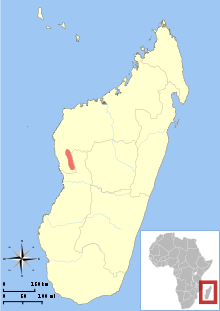Bemaraha woolly lemur
| Bemaraha woolly lemur | |
|---|---|
| Scientific classification | |
| Domain: | Eukaryota |
| Kingdom: | Animalia |
| Phylum: | Chordata |
| Class: | Mammalia |
| Order: | Primates |
| Suborder: | Strepsirrhini |
| Family: | Indriidae |
| Genus: | Avahi |
| Species: | A. cleesei
|
| Binomial name | |
| Avahi cleesei Thalmann & Geissmann, 2005[3]
| |

| |
| Distribution of A. cleesei[1] | |
The Bemaraha woolly lemur (Avahi cleesei), also known as Cleese's woolly lemur, is a species of woolly lemur native to western Madagascar, named after John Cleese. The first scientist to discover the species named it after Cleese, star of Monty Python, mainly because of Cleese's fondness for lemurs, as shown in Operation Lemur With John Cleese and Fierce Creatures, and his efforts at protecting and preserving them. The species was first recorded in 1990 by a team of scientists from Zurich University led by Urs Thalmann, but wasn't formally described as a species until 11 November 2005.[3]
The diurnal animal weighs about 5–6 kilograms (11–13 lb), has brown skin with white regions on the rear and inside of the thighs and has a short damp nose, large plate eyes, and ears which hardly stand out from the skin. It typically has a strictly vegetarian diet of leaves and buds, living together in small families. The local population calls the species dadintsifaky, which means "Grandfather of the sifaka", because it is similarly sized to sifakas, but more ponderous, heavyset and has ample greyish-brown fur.[3]
The habitat is limited to the Tsingy de Bemaraha Strict Nature Reserve in western Madagascar, which is a UNESCO World Heritage Site. The animal is probably threatened with becoming extinct in the long run, since the size of the population is unknown so far and its habitat shrinks continuously.[3]
Description
[edit]It is found in Western Madagascar, near the village of Ambalarano.[1] Its face is slightly more pale than its upper head, and the area above the nose extends to the forehead to contrast with the triangular pattern created by the forehead fur. The fur that borders the face is a black tone and forms a dark pattern in the shape of a line or stripe that resembles the letter "V". Its eyes are a maroon color with black eyelids, and the snout is black and hairless, while the corners of the mouth have a white tone.
The fur on the head and body is a brown-gray colour and has a slightly curled/freckled appearance. Its tail is beige or brownish-grey in colour, and slightly red on the dorsal side of the base. The surface colour of the lower limbs of the species is white, while the chest, belly and inner area of the upper limbs is a light grey colour with relatively thin fur.[4]
References
[edit]- ^ a b c Louis, E.E.; Raharivololona, B.; Schwitzer, C.; Wilmet, L. (2020). "Avahi cleesei". IUCN Red List of Threatened Species. 2020: e.T136335A115582253. doi:10.2305/IUCN.UK.2020-2.RLTS.T136335A115582253.en. Retrieved 19 November 2021.
- ^ "Checklist of CITES Species". CITES. UNEP-WCMC. Retrieved 18 March 2015.
- ^ a b c d Thalmann, U.; Geissmann, T. (2005). "New species of woolly lemur Avahi (Primates: Lemuriformes) in Bemaraha (Central Western Madagascar)" (PDF). American Journal of Primatology. 67 (3): 371–376. doi:10.1002/ajp.20191. PMID 16287101. S2CID 1790777.
- ^ Thelmann, U.; Geissmann, T. (2000). "Distribution and geographic variation in the western woolly lemur (Avahi occidentalis) with description of a new species (A. unicolor)" (PDF). International Journal of Primatology. 21 (6).

